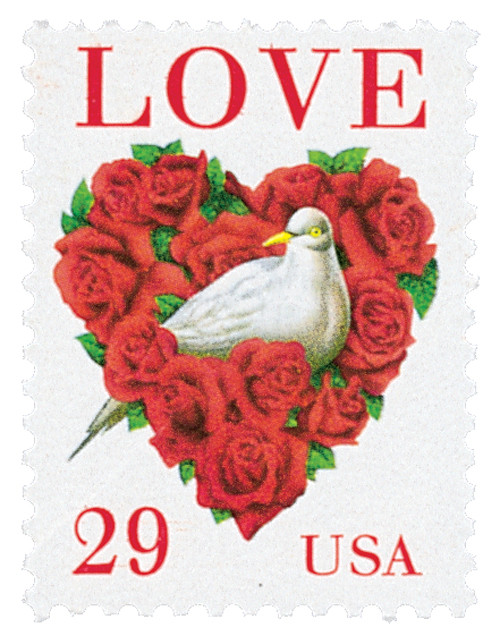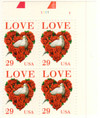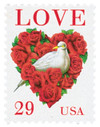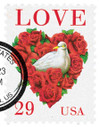
# 2814C - 1994 29c Love Series: Dove and Red Roses
U.S. #2814C
1994 29¢ Dove and Roses
Love Series
- The 14th US Love stamp
Stamp Category: Commemorative
Set: Love Series
Value: 29¢, rate for first-class mail
First Day of Issue: June 11, 1994
First Day City: Niagara Falls, NY
Quantity Issued: 300,000,000
Printed by: Bureau of Engraving and Printing
Printing Method: Lithographed and engraved
Format: Panes of 50 on offset printing plates of 300
Perforations: 11.25 x 11.2
Why the stamp was issued: For Valentine’s Day and other special occasions
About the stamp design: USPS art director Richard Sheaff provided a rough sketch for the stamp to artist Lon Busch. The stamp design was created to compliment the art on the 52¢ Love stamp issued the same day, which was based on an authentic Victorian item. The resulting air brushed image pictures a white dove in a heart-shaped bouquet of roses. As the USPS news release stated, the two stamps featured “Victorian-inspired visions of doves and roses.”
Special design details: This sheet stamp and the booklet stamp (#2814) have the same design, but there are some identifiable differences. First, the booklet stamps all have at least one straight edge, while the sheet stamps have perforations all around. The image area of the sheet stamp is slightly larger. Also, the stamps were printed by different companies. The Bureau of Engraving and Printing’s sheet stamp was printed in four offset colors (magenta, yellow, cyan, and gray), while the American Bank Note Company’s booklet stamp was printed with five gravure colors (red, green, yellow, black, and beige). As a result, the booklet stamp has beige-colored shading on the dove’s body while the sheet stamp has gray shading.
First Day City: Niagara Falls, NY – a popular honeymoon destination
About the Love Series: Based on the popularity of Christmas stamps, the USPS issued its first Love stamp in 1973. It wasn’t intended to be the start of a series, and in fact, it wasn’t until 1982 that another Love stamp was issued. Love-themed stamps were issued sporadically over the next few years. The USPS stated that they weren’t intended just for Valentine’s Day mail, but also for weddings, birthdays, anniversaries, and other special occasions. In 1987, the USPS officially declared it a series, and new Love stamps have been issued virtually every year since. Love stamps are classified as “special” stamps. They are on sale longer than commemoratives, are usually printed in greater quantities, and may go back to press to meet demand.
History the stamp represents: Doves have been a traditional wedding symbol for thousands of years. The dove represented innocence to the ancient Egyptians, love and devotion to the early Greeks and Romans, and peace and longevity to the ancient Chinese. The Roman goddess of love, Venus, made the dove a sacred animal. A groom gave a dove to the bride to show his commitment to her and her family. Doves are an appropriate symbol for eternal love since the birds mate for life. In recent years, releasing doves at weddings has become very popular in the US, both for the symbolism and for the spectacle. Of course, the “white doves” that are released at weddings are not doves at all, but white racing pigeons. Unlike real doves, the white pigeons have a homing instinct that ensures they will return to their owners and be cared for.
Though often connected with romance and passion in Greek and Roman mythology, it wasn’t until the Victorian era that the rose solidified its status as a symbol of love. At that time of high moral standards, floriography, the secret language of flowers, was used to convey otherwise inappropriate ideas too forbidden to speak about. Different flowers were given certain meanings, and dictionaries were published to define the various possible messages. Feelings could be expressed discreetly through a bouquet or a single flower. A white rose stood for innocence, orange for desire, pink for admiration, and purple for enchantment. A red rose suggested love and enduring passion, an association that still holds true today.
U.S. #2814C
1994 29¢ Dove and Roses
Love Series
- The 14th US Love stamp
Stamp Category: Commemorative
Set: Love Series
Value: 29¢, rate for first-class mail
First Day of Issue: June 11, 1994
First Day City: Niagara Falls, NY
Quantity Issued: 300,000,000
Printed by: Bureau of Engraving and Printing
Printing Method: Lithographed and engraved
Format: Panes of 50 on offset printing plates of 300
Perforations: 11.25 x 11.2
Why the stamp was issued: For Valentine’s Day and other special occasions
About the stamp design: USPS art director Richard Sheaff provided a rough sketch for the stamp to artist Lon Busch. The stamp design was created to compliment the art on the 52¢ Love stamp issued the same day, which was based on an authentic Victorian item. The resulting air brushed image pictures a white dove in a heart-shaped bouquet of roses. As the USPS news release stated, the two stamps featured “Victorian-inspired visions of doves and roses.”
Special design details: This sheet stamp and the booklet stamp (#2814) have the same design, but there are some identifiable differences. First, the booklet stamps all have at least one straight edge, while the sheet stamps have perforations all around. The image area of the sheet stamp is slightly larger. Also, the stamps were printed by different companies. The Bureau of Engraving and Printing’s sheet stamp was printed in four offset colors (magenta, yellow, cyan, and gray), while the American Bank Note Company’s booklet stamp was printed with five gravure colors (red, green, yellow, black, and beige). As a result, the booklet stamp has beige-colored shading on the dove’s body while the sheet stamp has gray shading.
First Day City: Niagara Falls, NY – a popular honeymoon destination
About the Love Series: Based on the popularity of Christmas stamps, the USPS issued its first Love stamp in 1973. It wasn’t intended to be the start of a series, and in fact, it wasn’t until 1982 that another Love stamp was issued. Love-themed stamps were issued sporadically over the next few years. The USPS stated that they weren’t intended just for Valentine’s Day mail, but also for weddings, birthdays, anniversaries, and other special occasions. In 1987, the USPS officially declared it a series, and new Love stamps have been issued virtually every year since. Love stamps are classified as “special” stamps. They are on sale longer than commemoratives, are usually printed in greater quantities, and may go back to press to meet demand.
History the stamp represents: Doves have been a traditional wedding symbol for thousands of years. The dove represented innocence to the ancient Egyptians, love and devotion to the early Greeks and Romans, and peace and longevity to the ancient Chinese. The Roman goddess of love, Venus, made the dove a sacred animal. A groom gave a dove to the bride to show his commitment to her and her family. Doves are an appropriate symbol for eternal love since the birds mate for life. In recent years, releasing doves at weddings has become very popular in the US, both for the symbolism and for the spectacle. Of course, the “white doves” that are released at weddings are not doves at all, but white racing pigeons. Unlike real doves, the white pigeons have a homing instinct that ensures they will return to their owners and be cared for.
Though often connected with romance and passion in Greek and Roman mythology, it wasn’t until the Victorian era that the rose solidified its status as a symbol of love. At that time of high moral standards, floriography, the secret language of flowers, was used to convey otherwise inappropriate ideas too forbidden to speak about. Different flowers were given certain meanings, and dictionaries were published to define the various possible messages. Feelings could be expressed discreetly through a bouquet or a single flower. A white rose stood for innocence, orange for desire, pink for admiration, and purple for enchantment. A red rose suggested love and enduring passion, an association that still holds true today.










